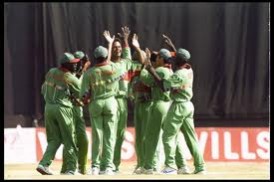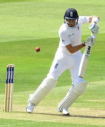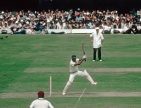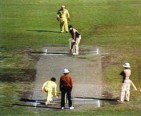“It’s Like Winning The World Cup” When Kenya Beat West Indies
Gareth Bland |
The twentieth game of the 1996 World Cup produced the tournament’s greatest shock and probably the biggest upset in the history of the competition. The contest in Pune, in the Indian state of Maharashtra, showed the cricket watching world that West Indies were more than just a side in transition. That Richie Richardson’s side eventually regrouped and reached the semi-finals, where they were defeated by Australia, is testament to their character, yet their stock had unmistakably fallen. After all, fifteen, ten or even five years earlier, such a match up as this would hardly have been thought a fair contest. Remarkably, the Caribbean outfit were blitzed by Kenya’s bowlers with a batting line-up which contained Richardson, Chanderpaul and Lara.
The portents were not good for Richardson’s men. The retirements of the recent greats of Caribbean cricket had been met with typical end of empire squabbling. Richardson, who had been feeling the strain since taking over from Richards would make this, at age 34, his last challenge in international cricket and would retire from all forms of the game, exhausted, at the end of it. He had been diagnosed with chronic fatigue syndrome and had already taken his leave of absence from the county game in England. Additionally, he had been required to weather the storm associated with a side in decline back home when Mark Taylor’s touring Australian’s had, to paraphrase Sir Alex Ferguson, knocked the Caribbean champions of Test cricket off their f******* perch in the 1995 Caribbean summer. Moreover, a 2-2 series draw with England away from home just months later had been the closest between the two teams since 1973/74, a sign of the ever decreasing gap between West Indies and the rest. The genius of Lara notwithstanding, along with the continued endurance and skill of the great Ambrose and Walsh, there was little to encourage optimism in the Windies camp ahead of the tournament.
West Indies’ early tournament form had been patchy with a six wicket win in their opener against Zimbabwe followed by an indifferent performance against India which they lost by five wickets. Then came the forfeiture against Sri Lanka at Colombo where Richardson’s team refused to play due to safety concerns. Then, on 29th February, with 1996 being a Leap Year, West Indies won the toss and elected to bowl first against Maurice Odumbe’s Kenyans. The minnows scrambled to an eventual 166 but some indisciplined bowling and slovenly outcricket meant that extras proved the highest scorer, adding some 37 to the total. Requiring a little over three runs an over, the Windies appeared to have little to be concerned about, though. How wrong that assumption would prove to be.
With 35 runs on the board Sherwin Campbell, Richardson, Lara and Keith Arthurton were all back in the pavillion. There was to be no rearguard, however, as only Chanderpaul and Roger Harper reached double figures. A further 17 came from sundries to bring the West Indies total to a pitiful 93 all out. It had been a truly wretched performance. Odumbe was named man of the match for his 3/15 off ten overs and, understandably, it was a historic and euphoric day for the East Africans.
Kenya’s proud captain Odumbe put things into perspective when he said “It’s like winning the World Cup. It’s a dream come true. The West Indies are our idols, and to beat an idol is a great thing.”. When Richardson followed up his fulsome congratulations to the Kenyan team with a terse “”We did not play the way we should have. I am very, very disappointed. I have nothing more to add” he was as good as his word. Years later, however, speaking from the tranquility of retirement, his reputation restored and mental scars healed, he added “I honestly thought that we could have won the World Cup. I felt let down by some of the players on that tour. We really should not have lost the match against Australia. I was just really really frustrated”. The “match against Australia” was, of course, the semi-final, a stage of the tournament that had looked fanciful after the Kenya defeat.
That West Indies should reach the ’96 semi-final was due in no small measure to the brilliance of Lara in the quarter final with South Africa, where a virtuoso 111 inspired his team to get beyond a Proteas side sans Allan Donald. Richie Richardson’s troubled tenure ended after the 1996 World Cup, the genial Antiguan having had enough of the captaincy and the game by this point. He had felt the heat from the beginning, though, after succeeding his great compatriot, Richards, when Viv himself had attempted to anoint Desmond Haynes as his successor.
The next few years were equally uneasy for West Indies, culminating in the farcical stand-off at Heathrow Airport en route to the South Africa series in 1998/99. Agitating for more pay, Lara’s team threatened to pull out of the tour unless their demands were met. A delegation even travelled up from South Africa brandishing a signed letter from President Mandela, Madiba himself, pleading for them to press ahead with the tour for the good of cricket in the rainbow nation. When the tour eventually did go ahead there must have been many in the Caribbean who wished that it had not, for the West Indians were thumped 5-0.
No longer the all-conquering outfit of old, they were a disorganised rabble, ranked only fourth in the world. At the conclusion of that tour even Lara admitted “we are not together as a team”. Quite what the tour manager of that South African odyssey, Clive Lloyd, felt about the episode we can only imagine. This was the man, after all, who two decades earlier had unified the competing islands into the most fearsome and disciplined unit of the age.





96 wasn’t it?
Comment by Julian87 | 12:00am GMT 1 March 2014